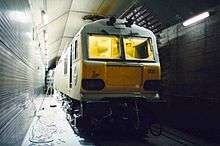Arsenal (Vienna)

The Arsenal is a former military complex of buildings in the south-east of Vienna in the third district.
Several brick buildings in a rectangle layout make up the complex which is located on a bank south of the Landstraßer Gürtel. It is the most distinguished building group of the romantic historism in Vienna and has been constructed in Italian-medieval respectively Byzantine-Islamic style. Essentially the complex is still preserved in its original form, merely a few workshop buildings within the courtyard were replaced.
Military history
The complex was built on the occasion of the March Revolution 1848 between 1848–1856 and was the first of three buildings which replaced the old city fortification. The area was split into sectors to cover with buildings by the architects Carl Roesner, Antonius Pius de Riegel, August Sicard von Sicardsburg, Eduard van der Nüll, Theophil von Hansen and Ludwig Förster. Master builder was Leopold Mayr. The Heeresgeschichtliche Museum took until 1891 to finish. In the aftermath there were multiple expansions. During First World War the complex served as barracks and armoury.
The Arsenal was not always part of the Third District, from its construction until 1938 it belonged to Favoriten. While Vienna was rearranged to form the new Reichsgau in Nazi Germany, inner city borders were reassigned and the Arsenal as well as the area south of it became part of Landstraße.
1945 the Arsenal was heavily damaged by bombing, however after the war most it was rebuilt into its original form. In the following years, several new constructions primarily in the south were undertaken, such as the workshops for the State Theatres (1959 until 1963) and the rehearsal stage for the Burgtheater in the 1990s. From 1961 until 1963 the Fernmeldezentralamt and 1973 buildings for the Post- und Telegraphendirektion für Wien, Niederösterreich und das Burgenland (mail and telegraph authority for Vienna, Lower Austria and Burgenland), today the Technologiezentrum Arsenal (technology centre Arsenal) of the Telekom Austria) with the 150 metre high Funkturm Arsenal.
The Österreichische Forschungs- und Prüfzentrum Arsenal (Austrian research and test-centre Arsenal), today Arsenal Research, was located in the complex. A small part of the complex is still being used by the Austrian army as a barracks. Furthermore the Zentraldesinfektionsanstalt (central disinfection authority) of Vienna is located there.
Part of the Arsenal now contains housing.
Testing facility

An area of the former site is now used by the not-for-profit Rail Tec Arsenal (RTA) research centre to provide climatic validation for rail and public transport vehicles.[1]
This facility contains a two climatic wind tunnels capable of simulating all combinations of weather by varying temperature, air pressure, humidity and wind-speed. The long wind tunnel allows testing up to three railway vehicles at once and has an operation length of 100 metres. The short wind tunnel allows testing of single vehicles or buses.[2]
See also
- Doriot Climatic Chambers a similar testing facility in the United States
References
- Peter & Wolfgang Schubert: Das Wiener Arsenal (Mayer & Comp), ISBN 3-902177-03-9
- Gerdenitsch, Josef: Das Wiener Arsenal in der Ersten Republik; die politische, wirtschaftliche und militärische Bedeutung in den Jahren 1918 - 1927. Universität Wien, Dissertation, 1968
- Schroll, Erich, Diemling, Alfred: Arsenal 2000; Bundesversuchs- und Forschungsanstalt Arsenal; anlässlich des 40-Jahr-Jubiläums. Metrica-Fachverlag Bartak, 1990, ISBN 3-900368-19-8
- ↑ "Our commitment". Archived from the original on 14 February 2009. Retrieved 2009-03-30.
Rail Tec Arsenal is not intended to make a profit but operates on a purely break-even basis. We are an international research and testing centre
- ↑ "Design". Rail Tec Arsenal. Archived from the original on 14 February 2009. Retrieved 2009-03-30.
two climatic wind tunnels (CWT) ... test section of the large CWT is 100 m long and can accommodate a train consisting of a power car and two carriages. At 31 meters, the test section of the small CWT is long enough to accommodate a carriage, a trailer truck or a bus.
-

Arsenal, Vienna (Museum of Military History, Vienna)
-

courtyard of the Arsenal complex
-

depots at the Arsenalstraße
-

Residential building Objekt 3
External links
- Arsenal Research
- RTA Rail Tec Arsenal Fahrzeugversuchsanlage Operator of the wind tunnel
- Heeresgeschichtliches Museum (military museum)://
- Testing of UK rolling stock Transit of BR stock to and from the Arsenal in 1989
Coordinates: 48°10′55″N 16°23′27″E / 48.18194°N 16.39083°E